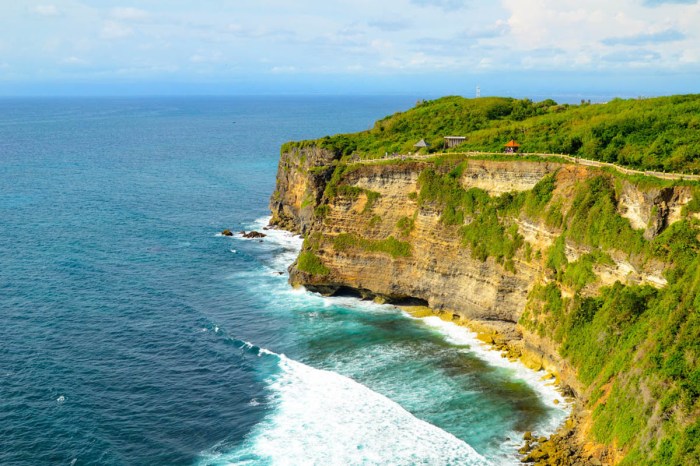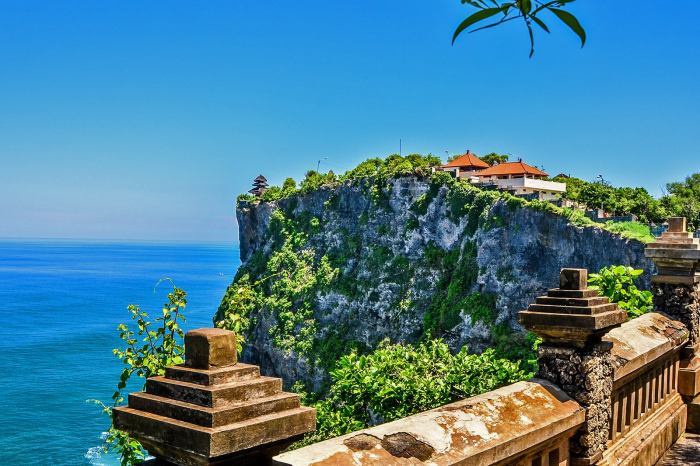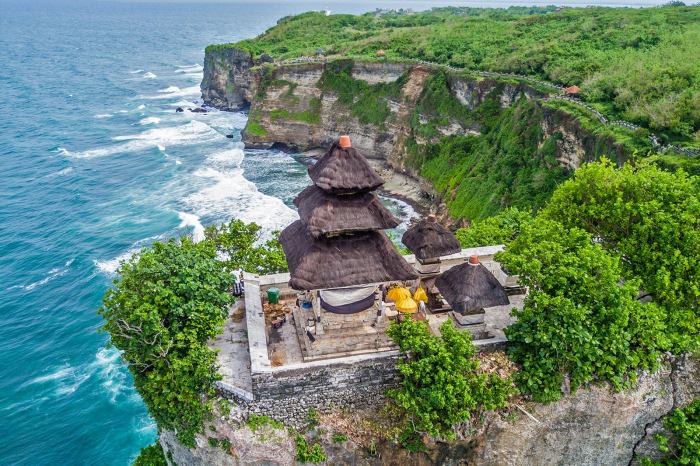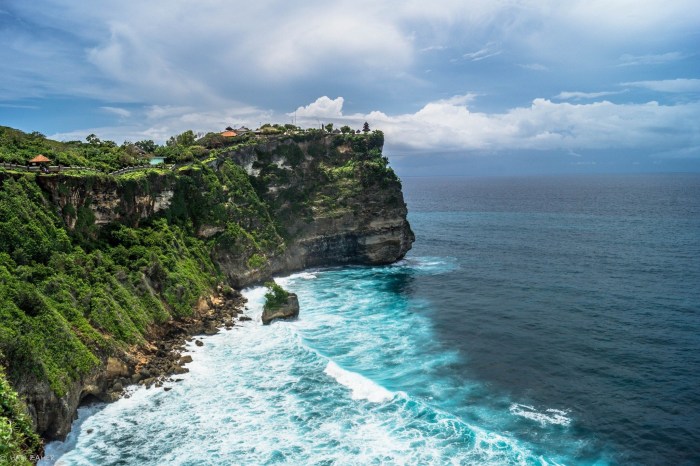Uluwatu, a captivating destination at the southernmost tip of Bali’s Bukit Peninsula, beckons travelers with its stunning natural beauty, rich cultural heritage, and vibrant tourism scene. From the iconic Uluwatu Temple perched on towering cliffs to the legendary surf breaks and pristine beaches, Uluwatu offers a harmonious blend of spirituality, adventure, and relaxation.
Delve into the cultural heart of Uluwatu, where ancient traditions and modern influences intertwine seamlessly. Explore the sacred Uluwatu Temple, a testament to Balinese artistry and religious devotion. Witness the mesmerizing Kecak Fire Dance, a vibrant performance that combines chanting, drumming, and fire-walking rituals.
Discover the unique arts and crafts of the local community, from intricate wood carvings to vibrant paintings and woven textiles.
Uluwatu Temple

Uluwatu Temple is a sacred Hindu temple located on the Bukit Peninsula in southern Bali, Indonesia. It is one of the nine directional temples of Bali and is believed to guard the island from evil spirits from the southwest.
The temple is perched on a steep cliff overlooking the Indian Ocean, and its name, Uluwatu, means “headland at the end of the earth.” The temple was built in the 11th century by the Javanese priest Empu Kuturan, and it has been a place of worship for centuries.
Architectural Features
Uluwatu Temple is a beautiful example of Balinese architecture. The temple is made up of several buildings, including a main temple, a meditation hall, and a purification temple. The main temple is the most sacred building in the complex, and it is where the main ceremonies are performed.
The temple is decorated with intricate carvings and sculptures, and it is surrounded by lush gardens. The gardens are home to a variety of plants and animals, including monkeys, deer, and peacocks.
Cultural and Religious Practices
Uluwatu Temple is a place of great cultural and religious significance for the Balinese people. The temple is dedicated to the god Shiva, and it is believed that the temple is a place where the god resides.
The Balinese people make regular pilgrimages to Uluwatu Temple to pray and make offerings to the god Shiva. The temple is also a popular tourist destination, and it is a great place to learn about Balinese culture and religion.
Daily Rituals and Ceremonies
There are several daily rituals and ceremonies that are performed at Uluwatu Temple. The most important ceremony is the daily Kecak dance, which is performed at sunset. The Kecak dance is a traditional Balinese dance that tells the story of the Ramayana.
If you’re looking for a stunning coastal escape, consider Uluwatu. This breathtaking destination boasts dramatic cliffs, pristine beaches, and world-class surf breaks. While exploring this captivating region, ensure you find comfortable accommodations to complement your adventure. Discover a range of hotels near me that cater to your needs, offering proximity to Uluwatu’s enchanting attractions and ensuring a memorable stay.
In addition to the Kecak dance, there are also several other daily ceremonies that are performed at the temple, including a morning offering ceremony, an evening prayer ceremony, and a midnight meditation ceremony.
Uluwatu Surf Spot

Uluwatu, located on the southern tip of the Bukit Peninsula in Bali, is a world-renowned surf break known for its challenging waves, breathtaking scenery, and vibrant surf culture. The unique reef structure and consistent swell conditions make Uluwatu a popular destination for surfers of all skill levels.The waves at Uluwatu are characterized by their size, shape, and consistency.
The main break, known as Outside Corner, is a long, powerful right-hander that breaks over a shallow reef. The wave is known for its speed, power, and hollow sections, making it a favorite among experienced surfers. Inside Corner, located on the inside of the reef, is a smaller, more forgiving wave that is suitable for surfers of all levels.
The Racetrack, located further down the coast, is a long, fast wave that is perfect for longboarders.Uluwatu is best surfed during the dry season, which runs from April to October. During this time, the prevailing wind and swell conditions are ideal for surfing.
The best time of day to surf is early morning or late afternoon, when the wind is typically lighter and the waves are more consistent.
Uluwatu Beach
Uluwatu Beach is a picturesque stretch of coastline located on the southernmost tip of Bali, Indonesia. With its pristine white sands, crystal-clear turquoise waters, and stunning limestone cliffs, it is a true natural paradise.
The beach offers a range of activities for visitors. Swimming in the calm waters is a popular choice, as is sunbathing on the soft sands. Snorkeling is also an excellent way to explore the vibrant marine life that inhabits the coral reefs just offshore.
Environmental Conservation
Uluwatu Beach is a protected area, and there are strict environmental conservation efforts in place to preserve its natural beauty and marine life. These efforts include regular beach cleanups, the prohibition of plastic bags and straws, and the establishment of a marine sanctuary to protect the coral reefs and fish populations.
Uluwatu Cliffs
The Uluwatu Cliffs, rising majestically along the southernmost tip of Bali, are a geological marvel formed over millions of years. The cliffs are primarily composed of limestone, which was once part of a coral reef that existed during the Pleistocene era.
Over time, the reef was uplifted and subjected to erosion by waves and wind, resulting in the formation of these dramatic cliffs.
Panoramic Views and Sunsets
The Uluwatu Cliffs offer breathtaking panoramic views of the Indian Ocean, the coastline, and the surrounding lush greenery. Visitors can witness the vast expanse of the ocean stretching out before them, dotted with surfers riding the waves. As the sun begins to set, the sky transforms into a canvas of vibrant colors, casting a magical glow upon the cliffs and the surrounding landscape.
Hiking Trails and Viewpoints
Along the Uluwatu Cliffs, there are several hiking trails that provide access to stunning viewpoints. The most popular trail is the one leading to the Uluwatu Temple, perched atop the cliffs. Along the way, hikers can enjoy panoramic views of the coastline and the temple’s iconic architecture.
Other trails lead to secluded viewpoints, offering a serene escape from the crowds and a chance to soak in the beauty of the natural surroundings.
Uluwatu Kecak Fire Dance

Originating from an ancient Hindu ritual, the Uluwatu Kecak Fire Dance is a mesmerizing performance that embodies the rich cultural heritage of Bali. The dance depicts the epic tale of the Ramayana, an ancient Indian epic, and is deeply rooted in Balinese mythology and spirituality.
Chanting and Drumming
The performance is characterized by a captivating chorus of male voices chanting in unison. The rhythmic chants, known as “kecak,” are accompanied by the hypnotic beat of bamboo sticks struck against each other. The combination creates a pulsating, almost trance-inducing atmosphere.
Fire-Walking Ritual
As the dance progresses, the performers engage in a thrilling fire-walking ritual. Embers are scattered across the ground, and the dancers walk barefoot through the flames, symbolizing their purification and connection to the divine.
Symbolism and Storytelling
The Uluwatu Kecak Fire Dance is a potent form of storytelling. The Ramayana narrative unfolds through the chanting and gestures of the performers, depicting the battle between good and evil, the power of love, and the triumph of dharma (righteousness).
Uluwatu Tourism

Uluwatu is a popular tourist destination in Bali, Indonesia, known for its stunning beaches, dramatic cliffs, and ancient temples. The tourism industry in Uluwatu is thriving, with a wide range of accommodations, restaurants, and activities available to visitors.
The economic impact of tourism on the local community is significant. Tourism provides employment opportunities for many local residents and supports local businesses. The revenue generated from tourism is also used to fund infrastructure development and social programs in the area.
Sustainable Tourism Practices
In recent years, there has been a growing emphasis on sustainable tourism practices in Uluwatu. Many businesses and organizations are working to reduce their environmental impact and promote responsible tourism. Some of the sustainable tourism practices being implemented in Uluwatu include:
- Reducing waste and using eco-friendly materials
- Conserving water and energy
- Protecting the local environment and wildlife
- Supporting local businesses and communities
Uluwatu Culture and Lifestyle
Uluwatu’s culture and lifestyle are deeply rooted in its ancient traditions and spiritual beliefs. The local community holds a profound respect for nature and the sacredness of their surroundings.
The people of Uluwatu live in harmony with the natural environment, relying on the land and sea for sustenance. They practice sustainable farming techniques and engage in traditional fishing methods, preserving the delicate balance of their ecosystem.
Traditional Customs and Beliefs
Uluwatu’s traditional customs and beliefs are centered around the concept of Tri Hita Karana, which emphasizes harmony between God, humans, and nature. The community follows strict rules and protocols during religious ceremonies and rituals, such as the Melasti purification ceremony and the Ngaben cremation ritual.
The people of Uluwatu believe in the existence of spirits and ancestors, who are revered and honored through offerings and prayers. They also practice traditional healing methods, using natural remedies and rituals to maintain well-being.
Daily Life and Livelihoods
The daily life of the Uluwatu community revolves around family, farming, and fishing. The community members are known for their strong work ethic and their close-knit social bonds. They participate in communal activities, such as temple ceremonies and festivals, which strengthen their sense of belonging.
The main livelihoods in Uluwatu are farming, fishing, and tourism. The community cultivates rice, vegetables, and fruits, while also engaging in small-scale fishing operations. In recent years, tourism has become an important source of income for the community, with visitors drawn to the area’s stunning beaches, surf breaks, and cultural heritage.
Uluwatu Art and Crafts

Uluwatu’s rich cultural heritage is reflected in its vibrant arts and crafts scene. Local artisans showcase their skills through traditional wood carving, painting, and weaving techniques, using indigenous materials to create unique and captivating pieces.
Wood Carving
Wood carving is a time-honored art form in Uluwatu. Artisans use intricate chisels and gouges to transform blocks of wood into intricate sculptures, masks, and decorative objects. The most commonly used wood is teak, renowned for its durability and resistance to decay.
Local wood carvers often incorporate motifs inspired by nature, religion, and Balinese mythology into their creations.
Painting
Traditional Uluwatu paintings are characterized by their vibrant colors and detailed brushwork. Artists use natural pigments derived from plants and minerals to create stunning works of art depicting scenes from daily life, religious ceremonies, and mythological tales. The most popular painting style in Uluwatu is the “wayang” style, which features stylized figures and elaborate ornamentation.
Weaving, Uluwatu
Weaving is another important craft in Uluwatu. Local artisans use traditional handlooms to create intricate textiles, including sarongs, scarves, and tapestries. The most common weaving techniques include ikat, where the threads are dyed before weaving, and songket, where gold or silver threads are woven into the fabric.
Uluwatu weavers often incorporate traditional patterns and motifs into their creations, making each piece a unique work of art.
Just 30 minutes away from the stunning Uluwatu Temple, you’ll find Pacific Place Mall , a modern shopping and entertainment destination. With over 200 stores, a cinema, and an array of dining options, it’s the perfect place to unwind after a day of exploring Uluwatu’s ancient ruins and breathtaking coastal views.
Where to Find and Purchase Authentic Uluwatu Crafts
Authentic Uluwatu crafts can be found in various locations throughout the region. Visitors can explore the local markets, such as the Sukawati Art Market, to find a wide selection of handmade goods. There are also several craft villages in Uluwatu, where visitors can witness artisans at work and purchase directly from the source.
Uluwatu is a captivating coastal paradise known for its stunning clifftop temple and mesmerizing sunsets. If you seek an unforgettable experience exploring this enchanting destination, consider booking a tour with golden rama tour and travel. Their knowledgeable guides and customized itineraries will lead you through the cultural and natural wonders of Uluwatu, ensuring an enriching and memorable journey.
Some popular craft villages include the Celuk Village for gold and silver jewelry, the Mas Village for wood carving, and the Ubud Village for painting and weaving.
Uluwatu Food and Cuisine

Uluwatu’s cuisine is a captivating blend of Balinese and Indonesian culinary traditions, boasting a rich tapestry of flavors that tantalize the taste buds. From succulent seafood to aromatic curries, the local dishes here offer a culinary adventure that will leave you craving for more.
One of the most popular local dishes is sate lilit, a flavorful minced meat satay marinated in a blend of spices and grilled to perfection. Another must-try is nasi goreng, a fragrant fried rice dish cooked with a variety of ingredients such as shrimp, chicken, and vegetables.
Seafood Delights
Uluwatu’s proximity to the ocean means that seafood plays a prominent role in the local cuisine. Freshly caught fish, shrimp, and lobster are grilled, fried, or steamed to create a variety of delectable dishes.
- Ikan bakar: Grilled fish marinated in a savory blend of spices and herbs.
- Udang goreng: Crispy fried shrimp served with a dipping sauce.
- Lobster Thermidor: A luxurious dish of lobster cooked in a creamy sauce.
Balinese Influences
Uluwatu’s cuisine has been heavily influenced by Balinese culinary traditions, particularly in the use of spices and herbs. Many dishes feature a complex blend of flavors, including turmeric, ginger, garlic, and chili peppers.
- Babi guling: A slow-roasted pork dish served with a spicy sauce.
- Lawar: A salad made with minced meat, vegetables, and spices.
- Satay lilit: Minced meat satay marinated in a blend of Balinese spices.
Indonesian Influences
Uluwatu’s cuisine has also been influenced by Indonesian culinary traditions, particularly from Java and Sumatra. This influence is evident in the use of ingredients such as coconut milk, tempeh, and tofu.
- Gado-gado: A salad made with vegetables, tofu, and tempeh served with a peanut sauce.
- Soto ayam: A chicken noodle soup with a flavorful broth.
- Rendang: A slow-cooked beef dish with a rich and spicy sauce.
Uluwatu Nightlife

Uluwatu boasts a vibrant nightlife scene, catering to various tastes and preferences. From lively bars and chic clubs to intimate live music venues, there’s something for everyone to enjoy after sunset.
The nightlife in Uluwatu is generally safe and secure, with a strong presence of security personnel in popular areas. Tourists can feel comfortable exploring the different establishments and enjoying the entertainment options without any major concerns.
Types of Entertainment
Uluwatu’s nightlife scene offers a diverse range of entertainment options:
- Live Music Venues:Several venues host live music performances, featuring local and international bands playing various genres, from traditional Balinese music to rock and reggae.
- Beach Clubs:Along the picturesque coastline, beach clubs offer a relaxed atmosphere with live DJs, cocktails, and dining options, creating a perfect setting for sunset gatherings and late-night parties.
- Rooftop Bars:Perched atop hotels and restaurants, rooftop bars provide stunning panoramic views of Uluwatu’s surroundings, accompanied by craft cocktails and chill-out music.
- Nightclubs:For those seeking a more energetic nightlife experience, Uluwatu has several nightclubs that feature international DJs, dance floors, and a vibrant party atmosphere.
Safety and Security
The safety and security of tourists are a priority in Uluwatu. The local authorities maintain a strong presence in popular nightlife areas, ensuring a safe and enjoyable experience for visitors.
Tourists are advised to take general safety precautions, such as being aware of their surroundings, avoiding excessive alcohol consumption, and keeping valuables secure.
Final Thoughts

As the sun dips below the horizon, Uluwatu transforms into a vibrant nightlife hub. From lively bars to open-air clubs, the nightlife scene offers a diverse range of entertainment options. Whether you seek a relaxed evening sipping cocktails or a night of dancing under the stars, Uluwatu caters to every taste.
Uluwatu’s allure extends beyond its cultural and natural wonders. The local community warmly welcomes visitors, sharing their traditions and way of life. Sustainable tourism practices are embraced throughout the region, ensuring that Uluwatu’s beauty and cultural heritage are preserved for generations to come.
Query Resolution
Is Uluwatu suitable for families?
Yes, Uluwatu offers family-friendly attractions such as the Uluwatu Temple and the Pandawa Beach, which are safe and enjoyable for children.
What is the best time to visit Uluwatu?
The dry season from April to October offers the most favorable weather conditions for exploring Uluwatu.
Are there any hiking trails in Uluwatu?
Yes, there are several scenic hiking trails along the Uluwatu Cliffs, providing breathtaking views of the coastline and surrounding landscapes.